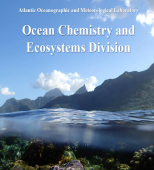About the Barcelona Express

In January of 2010, the Ocean Carbon Cycle (OCC) group at NOAA's Atlantic Oceanographic and Meteorological Laboratory (AOML) installed an automated system to measure surface pCO2 on the Hapag-Lloyd M/V Barcelona Express (ZCDJ6). Every month the M/V Barcelona Express repeats its cruise track between the Gulf of Mexico and Italy with several stops in the Mediterranean Sea along the coast of Italy, France and Spain and provides valuable coverage of several regions of interest. The installation was greatly facilitated by the cooperation of the ship's officers and crew, especially the engineers. The data are organized with each 4-week cruise beginning and ending in Port Everglades, FL. When the ship is underway, the pCO2 instrument takes 5 air and 100 water measurements every 4.5 hours. Data files are sent to AOML via Iridium satellite daily so that the system's operation can be monitored. The final data are processed after a cruise is completed and then posted to international databases and to this web site.
About this Website
This web site provides access to the data collected on this ship. The processed data are organized by year and by cruise. For each cruise, the color coded fCO2 values are plotted along the ship's cruise track on a chart. Next to each chart are links to the comma-delimited data file and the associated Readme file. To download a data file, select the year from the drop-down list box and click on GO. Choose a chart and cruise, right-click on the link to its data file or Readme file, and select the download option.
The Master Readme link in the menu bar on the left provides metadata that is applicable for all data gathered from this ship. The individual Readme files next to the charts provide metadata specific to the associated cruise. The Realtime Display link displays plots of the raw xCO2 data as a function of time and location. These plots are suitable for monitoring but are not suitable for environmental interpretation since the Realtime data has not been processed or quality controlled.
